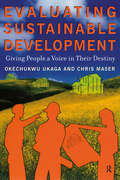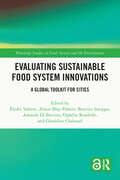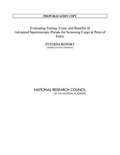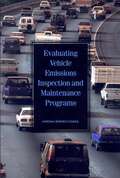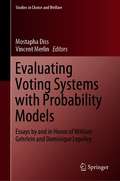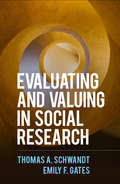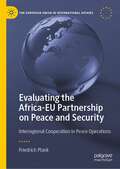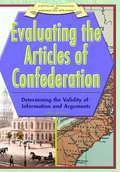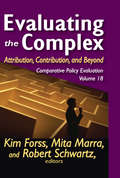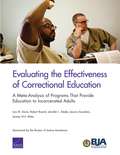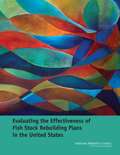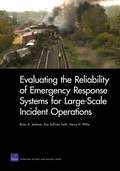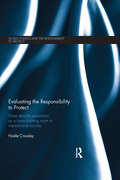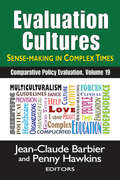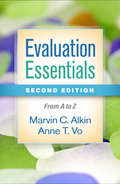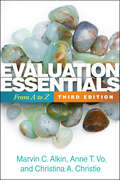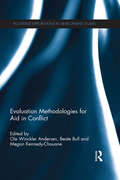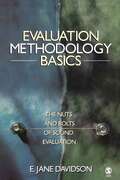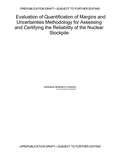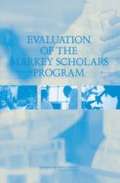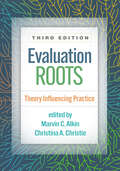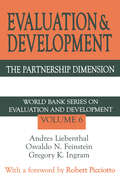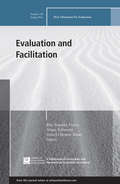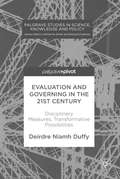- Table View
- List View
Evaluating Sustainable Development: Giving People a Voice in Their Destiny
by Chris Maser Okechukwu UkagaThis book presents the principles and the tools for participatory evaluation of sustainable development--growth that does not compromise the ability of future generations to meet their needs. It is intended for any citizen or group that may be concerned with protecting or recovering a cultural heritage, assessing the impact of a project or of plans that impact an environment or ecosystem.The authors describe participatory evaluation processes that will empower all interested "stakeholders"--anyone impacted by a proposed venture--to determine and control what is to be evaluated and how it is evaluated, to articulate and define their community’s vision, and to ensure that development plans meet their community’s needs sustainably. Acknowledging that the specific concepts, challenges, opportunities, and circumstances surrounding sustainable development differ significantly from one place or group to another, the authors provide an adaptable framework for developing an evaluation plan, as well as the tools for collecting, analyzing, interpreting and presenting data. They explain how to use and communicate findings to ensure a full and appropriate debate about the issues, and finally how to implement the evaluation plan.An important and practical book for anyone concerned with the impact of planning and development issues and who wants to ensure that all sectors of their community are given a voice in decisions that affect them.
Evaluating Sustainable Food System Innovations: A Global Toolkit for Cities (Routledge Studies in Food, Society and the Environment)
by Alison Blay-Palmer Élodie Valette Amanda Di Battista Beatrice Intoppa Ophélie Roudelle Géraldine ChaboudThis book presents URBAL, an approach that applies impact pathway mapping to understand how food system innovations in cities, and their territories, change and impact food system sustainability. Around the world, people are finding innovative ways to make their food systems more sustainable. However, documenting and understanding how these innovations impact the sustainability of food system can be a challenge. The Urban Driven Innovations for Sustainable Food Systems (URBAL) methodology responds to these constraints by providing innovations with a simple, open-source, resource-efficient tool that is easily appropriated and adaptable to different contexts. URBAL is designed to respond to the demands of field stakeholders, whether public or private, to accompany and guide them in their actions and decision-making with regard to sustainability objectives. This book presents this qualitative and participatory impact assessment method of food innovations and applies it to several cases of food innovation around the world, including the impact of agricultural districts in Milan, chefs and gastronomy in Brasilia, e-commerce in Vietnam, eco-friendly farm systems in Berlin and The Nourish to Flourish governance process in Cape Town. The book demonstrates how food innovations can impact different dimensions of sustainability, positively and negatively, and identify the elements that facilitate or hinder these impacts. The volume reflects on how to strengthen the capacity of these stakeholders to disseminate their innovations on other scales to contribute to the transition towards more sustainable food systems. This book will be of great interest to students and scholars working on sustainable food systems, urban food, food innovation and impact assessment, as well as policymakers, practitioners and funders interested in these areas.
Evaluating Testing, Costs, and Benefits of Advanced Spectroscopic Portals for Screening Cargo at Ports of Entry: Interim Report - (Abbreviated Version)
by National Research Council of the National AcademiesTo improve screening of containerized cargo for nuclear and radiological material that might be entering the United States, the Department of Homeland Security (DHS) is seeking to deploy new radiation detectors, called advanced spectroscopic portals (ASPs). The ASPs are intended to replace some or all of the current system of radiation portal monitors (called PVT RPMs) used in conjunction with handheld radioisotope identifiers (RIIDs) to detect and identify radioactive material in cargo. The U.S. Congress required the Secretary of Homeland Security to certify that ASPs will provide a 'significant increase in operational effectiveness' over continued use of the existing screening devices before DHS can proceed with full-scale procurement of ASPs for deployment. Congress also directed DHS to request this National Research Council study to advise the Secretary of Homeland Security about testing, analysis, costs, and benefits of the ASPs prior to the certification decision. This interim report is based on testing done before 2008; on plans for, observations of, and preliminary results from tests done in 2008; and on the agency's draft cost-benefit analysis as of October 2008. The book provides advice on how DHS' Domestic Nuclear Detection Office (DNDO) can complete and make more rigorous its ASP evaluation for the Secretary and the nation.
Evaluating Vehicle Emissions Inspection and Maintenance Programs
by Committee on Vehicle Emission Inspection Maintenance ProgramsEmissions inspection and maintenance (I/M) programs subject vehicles to periodic inspections of their emission control systems. Despite widespread use of these programs in air-quality management, policy makers and the public have found a number of problems associated with them. Prominent among these issues is the perception that emissions benefits and other impacts of I/M programs have not been evaluated adequately. Evaluating Vehicle Emissions Inspection and Maintenance Programsassesses the effectiveness of these programs for reducing mobile source emissions. In this report, the committee evaluates the differences in the characteristics of motor vehicle emissions in areas with and without I/M programs, identifies criteria and methodologies for their evaluation, and recommends improvements to the programs. Most useful of all, this book will help summarize the observed benefits of these programs and how they can be redirected in the future to increase their effectiveness.
Evaluating Voting Systems with Probability Models: Essays by and in Honor of William Gehrlein and Dominique Lepelley (Studies in Choice and Welfare)
by Mostapha Diss Vincent MerlinThis book includes up-to-date contributions in the broadly defined area of probabilistic analysis of voting rules and decision mechanisms. Featuring papers from all fields of social choice and game theory, it presents probability arguments to allow readers to gain a better understanding of the properties of decision rules and of the functioning of modern democracies. In particular, it focuses on the legacy of William Gehrlein and Dominique Lepelley, two prominent scholars who have made important contributions to this field over the last fifty years. It covers a range of topics, including (but not limited to) computational and technical aspects of probability approaches, evaluation of the likelihood of voting paradoxes, power indices, empirical evaluations of voting rules, models of voters’ behavior, and strategic voting. The book gathers articles written in honor of Gehrlein and Lepelley along with original works written by the two scholars themselves.
Evaluating and Valuing in Social Research
by Thomas A. Schwandt Emily F. GatesMuch applied research takes place as if complex social problems--and evaluations of interventions to address them--can be dealt with in a purely technical way. In contrast, this groundbreaking book offers an alternative approach that incorporates sustained, systematic reflection about researchers' values, what values research promotes, how decisions about what to value are made and by whom, and how judging the value of social interventions takes place. The authors offer practical and conceptual guidance to help researchers engage meaningfully with value conflicts and refine their capacity to engage in deliberative argumentation. Pedagogical features include a detailed evaluation case, "Bridge to Practice" exercises and annotated resources in most chapters, and an end-of-book glossary.
Evaluating the Africa-EU Partnership on Peace and Security: Interregional Cooperation in Peace Operations (The European Union in International Affairs)
by Friedrich PlankInterregional cooperation in peace and security as key feature of the EU external relations is particularly relevant in Africa-EU relations. However, these efforts have not been systematically evaluated to date. Focusing specifically on interregional peace operations, this volume provides the first comprehensive evaluation of the Africa-EU Partnership on Peace and Security. It explains the effectiveness of interregional security cooperation across three cases: (1) the AU-EU response in the Central African Republic (2013) and (2) in Somalia (2007–2017), (3) and the ECOWAS-EU efforts in Mali (2012). The book makes a valuable empirical, theoretical, and methodological contribution to EU foreign policy, comparative regionalism, and conflict studies.
Evaluating the Articles of Confederation: Determining the Validity of Information and Arguments (Critical Thinking in American History)
by Greg RozaThis is a fascinating look at the state of the nation at the time of the drafting of the Articles of Confederation seen against the backdrop of revolution, the various ideological debates and practical considerations that shaped it, and the document's inherent weaknesses that necessitated its replacement with the Constitution.
Evaluating the Complex: Attribution, Contribution and Beyond (Comparative Policy Evaluation)
by Mita MarraIn the economic atmosphere following the crisis of 2008, not only have governments reacted by creating more complex policy initiatives, but they have also promised that all of these initiatives will be evaluated. Due to the complexity of many of the initiatives, the ways of evaluating are becoming equally complex.The book begins with a theoretical and conceptual explanation of the process and shows how this translates into the practice of evaluation. The chapters cover a wide variety of subjects, such as poverty, homelessness, smoking prevention, HIV/AIDS, and child labor. The use of case studies sheds light on the conceptual ideas at work in organizations addressing some of the world's largest and most varied problems.The evaluation process seeks a balance between order and chaos. The interaction of four elements—simplicity, inventiveness, flexibility, and specificity—allows complex patterns to emerge. The case studies illustrate this framework and provide a number of examples of practical management of complexity, in light of contingency theories of the evaluation process itself. These theories in turn match the complexity of evaluated policies, strategies, and programs. The evaluation process is examined for its impact on policy outcomes and choices.
Evaluating the Effectiveness of Correctional Education: A Meta-Analysis of Programs That Provide Education to Incarcerated Adults
by Lois M. Davis Jessica Saunders Jennifer L. Steele Jeremy N. V. Miles Robert BozickAfter conducting a comprehensive literature search, the authors undertook a meta-analysis to examine the association between correctional education and reductions in recidivism, improvements in employment after release from prison, and other outcomes. The study finds that receiving correctional education while incarcerated reduces inmates' risk of recidivating and may improve their odds of obtaining employment after release from prison.
Evaluating the Effectiveness of Fish Stock Rebuilding Plans in the United States
by National Research CouncilIn the United States (U. S. ), the Fishery Conservation and Management Act of 1976, now known as the Magnuson-Stevens Fishery Conservation and Management Act (MSFCMA), was the first major legislation to regulate federal fisheries in the U. S. Fishery Conservation Zone (later designated as the U. S. exclusive economic zone). The re-authorization of the MSFCMA passed by Congress in 2006 included additional mandates for conserving and rebuilding fish stocks and strengthening the role of scientific advice in fisheries management. Approximately 20% of the fisheries that have been assessed are considered overfished according to the September 2012 stock status Report to Congress prepared by the U. S. National Oceanic and Atmospheric Administration (NOAA). Overfished refers to a stock that is below the minimum stock size threshold, commonly set to half the stock size at which maximum sustainable yield (MSY) is achieved. Under the provisions of the MSFCMA, rebuilding plans for overfished stocks should take no more than 10 years, except when certain provisions apply. Rebuilding mandates have led to substantial reductions in catch and effort for many fisheries, raising concerns about the consequent social and economic impacts to the fishing communities and industry. "Evaluating the Effectiveness of Fish Stock Rebuilding Plans in the United States" reviews the technical specifications that underlie current federally-implemented rebuilding plans, and the outcomes of those plans. According to this report, fisheries management has evolved substantially since 1977 when the U. S. extended its jurisdiction to 8 200 miles, in the direction of being more prescriptive and precautionary in terms of preventing overfishing and rebuilding overfished fisheries. However, the trade-offs between precaution and yield have not been fully evaluated. "Evaluating the Effectiveness of Fish Stock Rebuilding Plans in the United States" discusses the methods and criteria used to set target fishing mortality and biomass levels for rebuilding overfished stocks, and to determine the probability that a particular stock will rebuild by a certain date. This report will be of interest to the fishing industry, ecology professionals, and members of Congress as they debate the renewal of the Magnuson-Stevens Fishery Conservation and Management Act.
Evaluating the Reliability of Emergency Response Systems for Large-Scale Incident Operations
by Henry H. Willis Brian A. Jackson Kay Sullivan FaithThe ability to measure emergency preparedness is critical for policy analysis in homeland security. Yet it remains difficult to know how prepared a response system is to deal with large-scale incidents, whether it be a natural disaster, terrorist attack, or industrial or transportation accident. This volume describes a method, based on the concept of system reliability, for evaluating the preparedness of emergency response systems.
Evaluating the Responsibility to Protect: Mass Atrocity Prevention as a Consolidating Norm in International Society (Global Politics and the Responsibility to Protect)
by Noële CrossleyThis book evaluates the extent to which the Responsibility to Protect (R2P) has consolidated as a norm in international society. A consolidated norm in international society is defined here as a regularised pattern of behaviour that is widely accepted as appropriate within a given social context. The analysis is based on the assumption that the R2P could be regarded as a consolidated norm if it were applied consistently when genocide and other mass atrocities occur; and if international responses routinely conformed to the core principles inherent in the R2P: seeking government consent, multilateralism, prevention and regionalism. This book employs Finnemore and Sikkink’s norm lifecycle model to determine the putative norm’s degree of consolidation, with in-depth case studies of the international responses to crises in Darfur and Kenya serving to illuminate the findings. It advances the argument that, whilst the R2P had fully emerged as a prospective norm by 2005, it has not yet fully consolidated as an international norm. The R2P has been remarkably successful at pervading the international discourse but has been somewhat less successful at consistency in implementation in terms of adherence to its core principles as outlined above (the qualitative dimension of the R2P). Furthermore, it has been least successful, to date, in terms of consistency across cases in terms of resolve and tenacity. The volume concludes with a reflection on the norm's progress so far, and its prospects for further consolidation, assuming the R2P continues on its current trajectory. This book will be of much interest to students of the Responsibility to Protect, humanitarian intervention, international law, security studies and IR.
Evaluation Cultures: Sense-Making in Complex Times (Comparative Policy Evaluation Ser.)
by Penny Hawkins Jean-Claude BarbierEvaluation Cultures draws upon a sample of reflections, drawn from organizational practices, nationally centered political cultures, and ethnic cultures, as a framework for understanding how culture influences the work of evaluation. Two main conclusions seem to emerge: first, that there exists no single, uniform, and homogenous national evaluation culture; second, that the idea of a unified transnational culture of evaluation is an illusion.The evaluation community includes a diverse group of professionals; a diversity that is not just represented in national or ethnic culture but also in academic backgrounds, public and private sector allegiances, and personal character. The contributors to this book represent, in part, this diversity by reflecting a range of views.Evaluation Cultures draws upon the experience of senior evaluation practitioners, who share their reflections on their practice and experience, in order to put forth challenges to purely academic analysis. Evaluation Cultures presents a consistent, if not exhaustive, attempt to give analytical and empirical sense to all of the cultures of the evaluation community.
Evaluation Essentials
by Marvin AlkinWritten in a refreshing conversational style, this text thoroughly prepares students, program administrators, and new evaluators to conduct evaluations or to use them in their work. The book's question-driven focus and clear discussions about the importance of fostering evaluation use by building collaborative relationships with stakeholders set it apart from other available texts. In 26 concise sections, Marvin C. Alkin explores how to articulate answerable evaluation questions, collect and analyze data using both quantitative and qualitative methods, and deal with contingencies that might alter the traditional sequence of an evaluation. Student-friendly features include handy bulleted recaps of each section, "Thinking Ahead" and "Next Steps" pointers, cautionary notes, annotated suggestions for further reading, and an in-depth case study that provides the basis for end-of-chapter exercises.
Evaluation Essentials, Second Edition: From A to Z
by Marvin C. Alkin Anne T. VoThoroughly revised and updated, this engaging text has given thousands of students and new evaluators the practical information and expert advice needed to conduct or use evaluations. In 26 concise sections, the book describes how to articulate answerable evaluation questions, collect and analyze data using both quantitative and qualitative methods, and deal with contingencies that might alter the traditional sequence of an evaluation. Special strengths of the text are its attention to individual, organizational, and community culture and emphasis on building collaborative relationships with stakeholders. An in-depth case study and related end-of-section exercises (including group activities) help students put themselves in the evaluator role. Other pedagogical features include section titles written as questions, bulleted recaps of each section, "Thinking Ahead" and "Next Steps" pointers, cautionary notes, and suggestions for further reading. New to This Edition *New and expanded topics: evaluation contracts, budgeting, surveys, data visualization, qualitative coding and memoing, factors affecting evaluation use, and context-sensitive evaluation. *Revised case study with extended exercises that guide the reader to complete a simulated evaluation. *End-of-section "Quick Read" links to recommended American Evaluation Association blog posts. *Four entirely new sections (such as "How Do You Strengthen Relationships with Stakeholders?" and "How Do We Plan a Process-Focused Evaluation Design?"), plus other changes and additions throughout.
Evaluation Essentials: From A to Z
by Christina A. Christie Marvin C. Alkin Anne T. VoBeloved for its conversational style and reliable advice, this text is now in a revised and updated third edition, reflecting key developments in evaluation. It includes expanded coverage of equity and social justice issues, values and cost analysis, visualizing qualitative data with software, and more. Twenty-six concise chapters, or "sessions," give students, applied researchers, and program administrators a solid foundation for conducting or using evaluations. Covering both quantitative and qualitative methods, the book emphasizes fostering evaluation use. It shows how to build collaborative relationships with users; formulate answerable evaluation questions; deal with contingencies that might alter the traditional sequence of an evaluation; and collect, analyze, and report data. Student-friendly features throughout the sessions include titles written as questions, bulleted recaps, "Thinking Ahead" and "Next Steps" pointers, cautionary notes, and annotated suggestions for further reading. An in-depth case study provides the basis for end-of-session practice exercises. New to This Edition *New sessions on context-sensitive evaluation, including the organizational, sociopolitical, and community contexts of a program. *New or expanded discussions of timely topics: identifying evaluation decision makers, analyzing program costs, coding and visualizing qualitative data with software, and more. *Updated suggestions for further reading and discussion in every chapter.
Evaluation Methodologies for Aid in Conflict (Routledge Explorations in Development Studies)
by Ole Winckler Andersen Beate Bull Megan Kennedy-ChouaneKnowledge and rigorous evidence around the role of external development partners in situations of conflict and fragility is still lacking. There is little accountability for the billions in aid being spent in places like Afghanistan, Iraq and the Democratic Republic of Congo. This book analyses evaluation theory and practice in order to help fill this knowledge gap and advocates a realistic and rigorous approach to evaluating international engagement. Through a series of case studies, this book highlights both the promise, and potential pitfalls, of taking a more evaluative approach to understanding aid in conflict regions. These illustrate the methodological and analytical approach taken by researchers working to understand the results and effectiveness of conflict prevention and peacebuilding support. While well-grounded in current theoretical and methodological debates, the book provides valuable practical information by examining how and why different choices were made in the context of each evaluation. The book shows what future steps may be envisaged to further strengthen evaluations of support for conflict prevention and peacebuilding. The analysis draws on a wealth of perspectives and voices to provide researchers and students in development studies and conflict and peace studies as well as development evaluators with a deep and broad understanding of evaluation methods and approaches.
Evaluation Methodology Basics: The Nuts and Bolts of Sound Evaluation
by E. Jane DavidsonEvaluation Methodology Basics: The Nuts and Bolts of Sound Evaluation provides a step-by-step guide for doing a real evaluation. It focuses on the main kinds of "big picture" questions that evaluators usually need to answer, and how the nature of such questions is linked to evaluation methodology choices. Jane Davidson explains how to combine a mix of qualitative and quantitative data with "relevant values" (such as needs) to draw explicitly evaluative conclusions. The book presents readers with useful rubrics and flowcharts that may be used during each stage of the evaluation. Many of the concepts presented in the chapters are illustrated with specific examples from a range of disciplines.
Evaluation Of Quantification Of Margins And Uncertainties Methodology For Assessing And Certifying The Reliability Of The Nuclear Stockpile
by National Research Council of the National AcademiesMaintaining the capabilities of the nuclear weapons stockpile and performing the annual assessment for the stockpile's certification involves a wide range of processes, technologies, and expertise. An important and valuable framework helping to link those components is the quantification of margins and uncertainties (QMU) methodology. In this book, the National Research Council evaluates: how the national security labs were using QMU, including any significant differences among the three labs its use in the annual assessment whether the applications of QMU to assess the proposed reliable replacement warhead (RRW) could reduce the likelihood of resuming underground nuclear testing This book presents an assessment of each of these issues and includes findings and recommendations to help guide laboratory and NNSA implementation and development of the QMU framework. It also serves as a guide for congressional oversight of those activities.
Evaluation Of The Markey Scholars Program
by National Research Council of the National AcademiesOne of five in a series evaluating the grant programs of the Lucille P. Markey Charitable Trust, this report examines the Markey Scholars Awards in Biomedical Sciences. The Scholars program awarded more than $50 million to outstanding young investigators as postdoctorates and junior faculty. Using analysis of curriculum vitae, data on citations and grants, and interviews, the report examines the career outcomes of Scholars relative to those of individuals who applied for the Scholars award. The authoring committee concludes that the Scholars program was a success and provides a template for current programs designed to address the career transitions of young investigators.
Evaluation Roots: Theory Influencing Practice
by Christina A. Christie Marvin C. AlkinShowing how evaluation practice looks when guided by theory, the third edition of the influential "theory tree" book is significantly revised with over 80% new material, including a greater focus on equity and theories over theorists. Chapters from leading authorities describe the goals of each theory; the type of evaluation for which it is appropriate (formative, summary formative, summative, adaptive); the size of the program for which it is most applicable; specific prescriptions; and observable actions that help to define the theory. Readers are given the tools to select suitable approaches for the size, contexts and stage of an evaluation and their own personal values. New to This Edition *Chapters on culturally responsive evaluation, Indigenous evaluation, and developmental evaluation. *Organized around theories rather than individual theorists. *Increased attention to practical applications, including a chapter distilling the goals, methods, and standards of evaluations based on each theory. *Case study chapter on the role of theory in evaluation policy.
Evaluation and Development: The Partnership Dimension World Bank Series on Evaluation and Development (World Bank Series On Evaluation And Development Ser. #Vol. 6)
by Osvaldo N. Feinstein Andres Liebenthal Gregory K. IngramPartnership is of growing importance in development work. Partnerships among state, private business, and civil society organizations are increasingly used to deliver the goods and services required for balanced growth and poverty reduction. Aid activities have shifted from a project focus to a more strategic and holistic focus on programs, sectors, and policies. With this new orientation, partnerships are often essential to deal with the added complexity and the larger number of agencies, groups, and stakeholders involved.The Partnership Dimension takes on the issues in a series of chapters divided into two general parts: Part 1, "Foundations of Partnership and Their Evaluation," covers the types of development partnership and critical issues involved, and Part 2, "Partnerships in Practice," then illustrates the aspects and lessons of partnership experience through a series of case studies. Many of the studies focus on the benefits of partnerships between institutions of government and civil society. Benefits include effective knowledge transfer, greater cross-national cooperation, the creation of new networks and capacity, and penetration of new markets. Private firms use partnerships with competitors to learn or reduce risk.There is much to learn about when, where, and how best to use partnerships, and, in particular, partnerships that involve less traditional combinations of actors, such as global partnerships for public policy, country-focused aid partnerships, private sector partnerships for knowledge creation, and partnerships for community development involving business, nongovernmental organizations, and government.Relatively little is known about the costs and benefits, and the risks and rewards, of different types of partnerships, or about how best to conduct partnerships for different purposes. This is why the current volume in the World Bank series is relevant for both development practitioners and policy analysts.
Evaluation and Facilitation, EV 149
by Rita Sinorita Fierro Alissa Schwartz Dawn Hanson SmartJoin the conversation between evaluation and facilitation. This issue explores the interplay between the two and how one practice can inform the other. The authors represent both the evaluation and facilitation fields, describing underlying concepts that inform their practices, the competencies they seek to develop, the choices they make about facilitation in the work they do, and how they gauge success. This issue brings together topics meant to stimulate the curiosity of evaluators and facilitators and encourage reflection on their work and the skills needed to carry it out.This is the 149th issue in the New Directions for Evaluation series from Jossey-Bass. It is an official publication of the American Evaluation Association.
Evaluation and Governing in the 21st Century
by Deirdre Niamh DuffyThis book interrogates the role played by evaluation in 21st century governing. Using youth work in the UK as a case study, it challenges the narrative of evidence-based policy-making, arguing instead that evaluation research is used to discipline and control. At the same time, drawing on the work of Michel Foucault and Gilles Deleuze, this book argues that evaluation can be reclaimed and facilitate transformation. In bringing these theoretically rich discussions to bear on the domain of contemporary evaluation, the author provokes an alternative reading of the relationship between research and governing, emphasising how knowledge production has historically been manipulated by elites towards their own political ends. As the debate around elite's use of research expands globally, this book is a nuanced interjection into both established evidence-based policy and emergent narratives of 'post-truth'. Challenging and provocative, this innovative work will appeal to students and scholars of social and public policy, and governance and public management.
